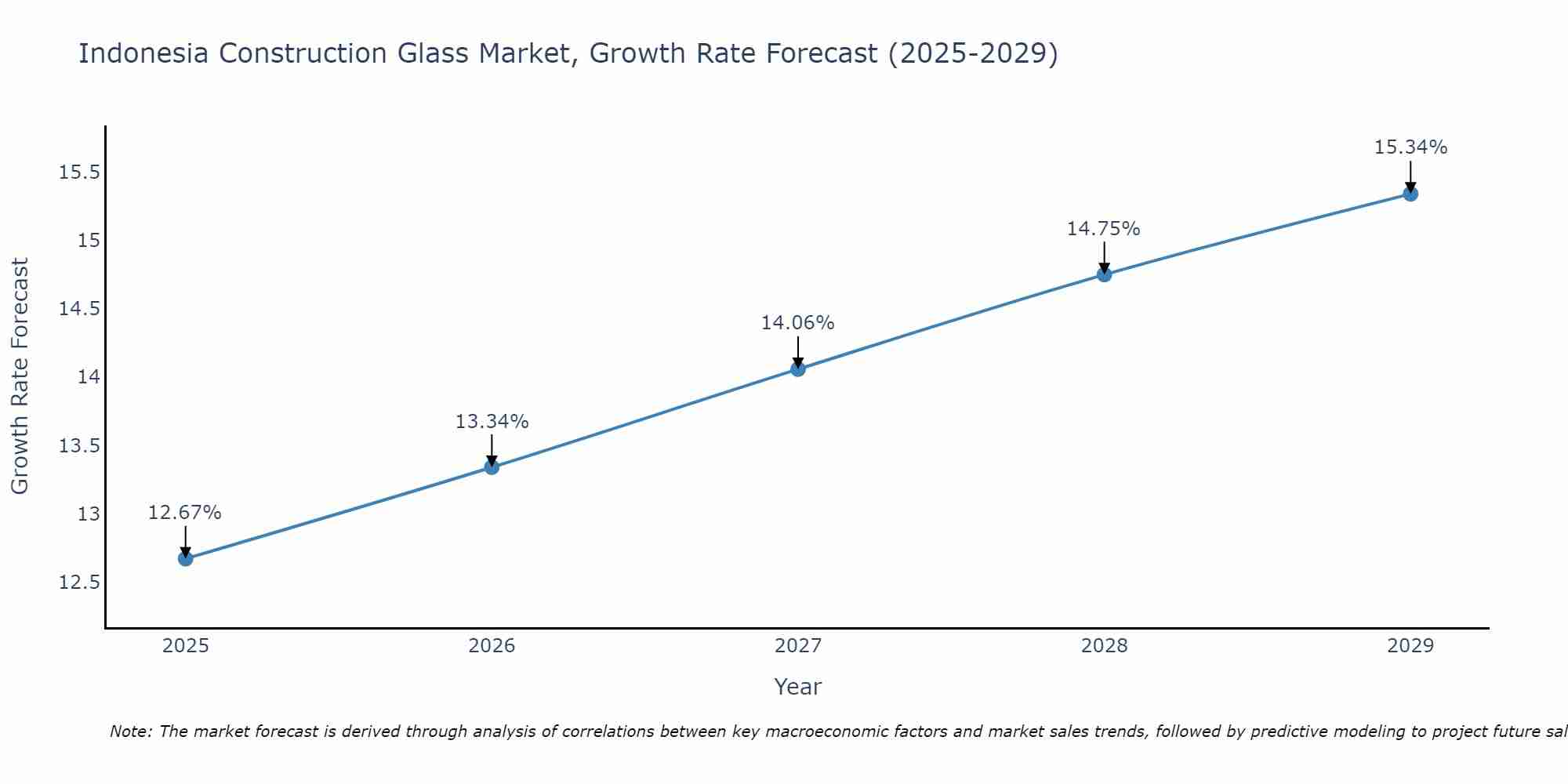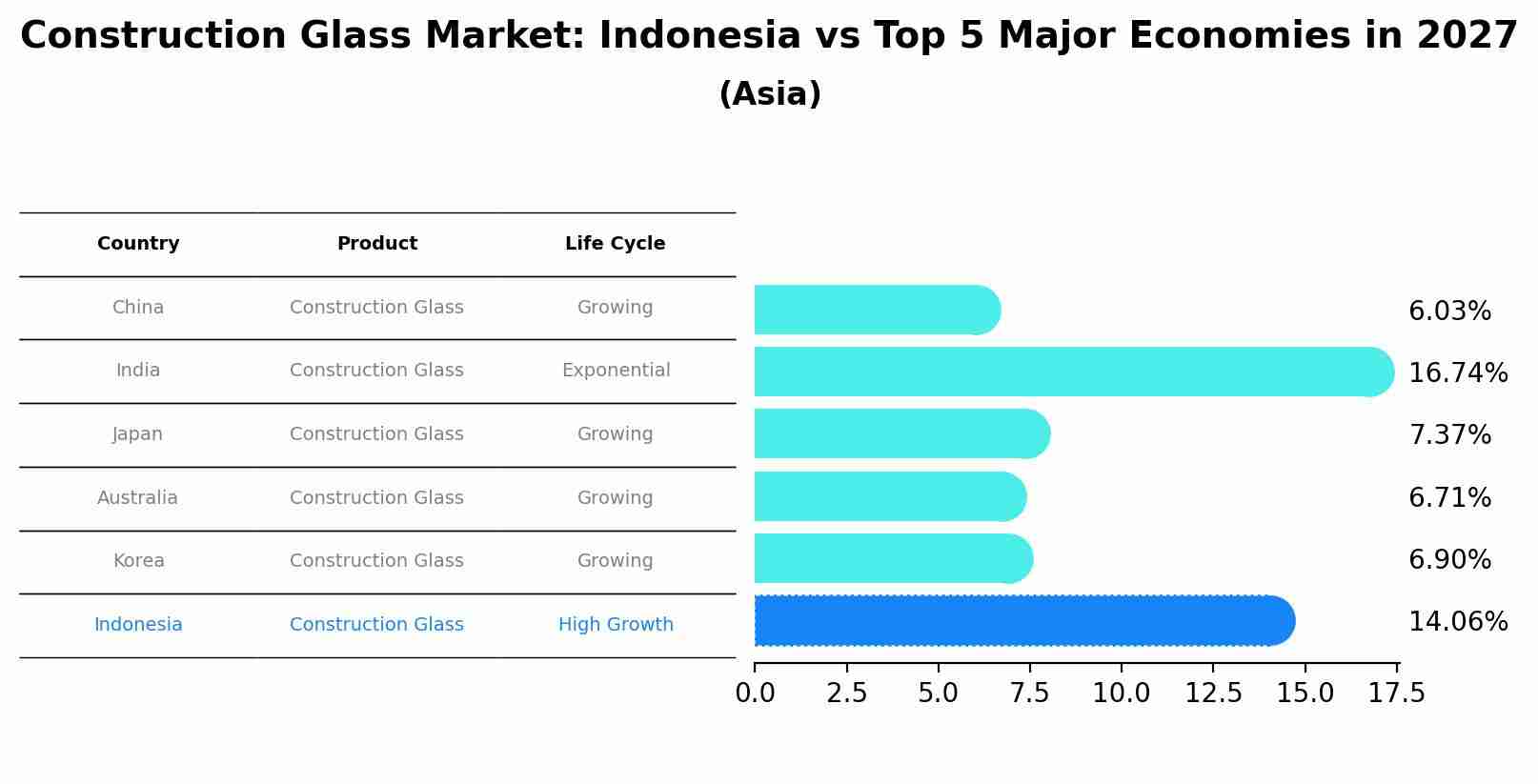Indonesia Construction Glass Market (2025-2031) Outlook | Companies, Value, Revenue, Size, Industry, Growth, Trends, Analysis, Forecast & Share
| Product Code: ETC355348 | Publication Date: Aug 2022 | Updated Date: Apr 2025 | Product Type: Market Research Report | |
| Publisher: 6Wresearch | No. of Pages: 75 | No. of Figures: 35 | No. of Tables: 20 | |
Indonesia Construction Glass Market Size Growth Rate
The Indonesia Construction Glass Market is likely to experience consistent growth rate gains over the period 2025 to 2029. Commencing at 12.67% in 2025, growth builds up to 15.34% by 2029.

Construction Glass Market: Indonesia vs Top 5 Major Economies in 2027 (Asia)
Indonesia's Construction Glass market is anticipated to experience a high growth rate of 14.06% by 2027, reflecting trends observed in the largest economy China, followed by India, Japan, Australia and South Korea.

Indonesia Construction Glass Market Synopsis
The construction glass market in Indonesia is experiencing robust growth, driven by the booming construction sector. Glass is used extensively in building facades, windows, and interior design due to its aesthetic appeal and energy-efficient properties. With increased urbanization and a rising middle-class population, there is a growing demand for modern and sustainable building materials, further fueling the adoption of construction glass. Additionally, government regulations promoting green and energy-efficient buildings are boosting the market.
Drivers of the Market
The Indonesia Construction Glass market has experienced robust growth due to several influential drivers. Firstly, the rapid urbanization and infrastructure development in the country have led to increased demand for construction materials, with glass being a crucial component. Glass is favored in modern architectural designs for its aesthetic appeal and energy-efficient properties. Furthermore, the government`s initiatives to promote sustainable building practices and energy conservation have encouraged the use of energy-efficient glass products, driving market growth. Moreover, the growing awareness among consumers about the benefits of natural light and transparency in buildings has fueled the demand for larger glass surfaces, such as windows and facades, in construction projects.
Challenges of the Market
The construction glass market in Indonesia is influenced by economic conditions and construction activity levels. Economic downturns can lead to reduced construction projects, impacting the demand for construction glass. Additionally, concerns related to safety standards and the need for high-quality, energy-efficient glass can pose challenges for manufacturers. Meeting these standards while maintaining cost-effectiveness can be a balancing act.
COVID-19 Impact on the Market
The construction glass market took a hit as construction projects were halted or delayed due to the pandemic. The demand for architectural and decorative glass products decreased significantly. Manufacturers faced challenges in terms of labor shortages and supply chain disruptions. However, with the government`s focus on infrastructure development and the resumption of construction activities, the market is poised for a comeback.
Key Players in the Market
The construction glass market in Indonesia is experiencing rapid growth, driven by urbanization and infrastructure development. Key players like PT Asahimas Flat Glass Tbk and PT Mulia Industrindo Tbk are leading suppliers of construction glass solutions. These companies offer a wide range of glass products, including energy-efficient and safety glass, to meet the evolving needs of the construction industry. With a focus on sustainable and aesthetically pleasing designs, the construction glass market in Indonesia is poised for continued expansion.
Key Highlights of the Report:
- Indonesia Construction Glass Market Outlook
- Market Size of Indonesia Construction Glass Market, 2024
- Forecast of Indonesia Construction Glass Market, 2031
- Historical Data and Forecast of Indonesia Construction Glass Revenues & Volume for the Period 2021-2031
- Indonesia Construction Glass Market Trend Evolution
- Indonesia Construction Glass Market Drivers and Challenges
- Indonesia Construction Glass Price Trends
- Indonesia Construction Glass Porter's Five Forces
- Indonesia Construction Glass Industry Life Cycle
- Historical Data and Forecast of Indonesia Construction Glass Market Revenues & Volume By Chemical Composition for the Period 2021-2031
- Historical Data and Forecast of Indonesia Construction Glass Market Revenues & Volume By Soda-lime for the Period 2021-2031
- Historical Data and Forecast of Indonesia Construction Glass Market Revenues & Volume By Potash-lime for the Period 2021-2031
- Historical Data and Forecast of Indonesia Construction Glass Market Revenues & Volume By Potash-lead for the Period 2021-2031
- Historical Data and Forecast of Indonesia Construction Glass Market Revenues & Volume By Type for the Period 2021-2031
- Historical Data and Forecast of Indonesia Construction Glass Market Revenues & Volume By Low-e Glass for the Period 2021-2031
- Historical Data and Forecast of Indonesia Construction Glass Market Revenues & Volume By Special Glass for the Period 2021-2031
- Historical Data and Forecast of Indonesia Construction Glass Market Revenues & Volume By Manufacturing Process for the Period 2021-2031
- Historical Data and Forecast of Indonesia Construction Glass Market Revenues & Volume By Float Process for the Period 2021-2031
- Historical Data and Forecast of Indonesia Construction Glass Market Revenues & Volume By Rolled/sheet Process for the Period 2021-2031
- Historical Data and Forecast of Indonesia Construction Glass Market Revenues & Volume By Application for the Period 2021-2031
- Historical Data and Forecast of Indonesia Construction Glass Market Revenues & Volume By Residential for the Period 2021-2031
- Historical Data and Forecast of Indonesia Construction Glass Market Revenues & Volume By Commercial for the Period 2021-2031
- Historical Data and Forecast of Indonesia Construction Glass Market Revenues & Volume By Others for the Period 2021-2031
- Indonesia Construction Glass Import Export Trade Statistics
- Market Opportunity Assessment By Chemical Composition
- Market Opportunity Assessment By Type
- Market Opportunity Assessment By Manufacturing Process
- Market Opportunity Assessment By Application
- Indonesia Construction Glass Top Companies Market Share
- Indonesia Construction Glass Competitive Benchmarking By Technical and Operational Parameters
- Indonesia Construction Glass Company Profiles
- Indonesia Construction Glass Key Strategic Recommendations
Frequently Asked Questions About the Market Study (FAQs):
- Single User License$ 1,995
- Department License$ 2,400
- Site License$ 3,120
- Global License$ 3,795
Search
Related Reports
- Portugal Electronic Document Management Market (2025-2031) | Strategy, Consumer Insights, Analysis, Investment Trends, Opportunities, Growth, Size, Share, Industry, Revenue, Segments, Value, Segmentation, Supply, Forecast, Restraints, Outlook, Competition, Drivers, Trends, Demand, Pricing Analysis, Competitive, Strategic Insights, Companies, Challenges
- France Electronic Document Management Market (2025-2031) | Strategy, Consumer Insights, Analysis, Investment Trends, Opportunities, Growth, Size, Share, Industry, Revenue, Segments, Value, Segmentation, Supply, Forecast, Restraints, Outlook, Competition, Drivers, Trends, Demand, Pricing Analysis, Competitive, Strategic Insights, Companies, Challenges
- Portugal Occupational Health & Safety Services Market (2025-2031) | Strategy, Consumer Insights, Analysis, Investment Trends, Opportunities, Growth, Size, Share, Industry, Revenue, Segments, Value, Segmentation, Supply, Forecast, Restraints, Outlook, Competition, Drivers, Trends, Demand, Pricing Analysis, Competitive, Strategic Insights, Companies, Challenges
- Netherlands Occupational Health and Safety Services Market (2025-2031) | Strategy, Consumer Insights, Analysis, Investment Trends, Opportunities, Growth, Size, Share, Industry, Revenue, Segments, Value, Segmentation, Supply, Forecast, Restraints, Outlook, Competition, Drivers, Trends, Demand, Pricing Analysis, Competitive, Strategic Insights, Companies, Challenges
- Belgium and Luxembourg Facility Management Market (2025-2031) | Strategy, Consumer Insights, Analysis, Investment Trends, Opportunities, Growth, Size, Share, Industry, Revenue, Segments, Value, Segmentation, Supply, Forecast, Restraints, Outlook, Competition, Drivers, Trends, Demand, Pricing Analysis, Competitive, Strategic Insights, Companies, Challenges
- Russia Women Intimate Apparel Market (2025-2031) | Strategy, Consumer Insights, Analysis, Investment Trends, Opportunities, Growth, Size, Share, Industry, Revenue, Segments, Value, Segmentation, Supply, Forecast, Restraints, Outlook, Competition, Drivers, Trends, Demand, Pricing Analysis, Competitive, Strategic Insights, Companies, Challenges
- Africa Chocolate Market (2025-2031) | Size, Share, Trends, Growth, Revenue, Analysis, Forecast, industry & Outlook
- Global Hydroxychloroquine And Chloroquine Market (2025-2031) | Industry, Trends, Size, Outlook, Growth, Value, Companies, Revenue, Analysis, Share, Forecast
- Saudi Arabia Plant Maintenance Market (2025-2031) | Industry, Size, Growth, Revenue, Value, Companies, Forecast, Analysis, Share & Trends
- Taiwan Electric Truck Market (2025-2031) | Outlook, Industry, Revenue, Size, Forecast, Growth, Analysis, Share, Companies, Value & Trends
Industry Events and Analyst Meet
Our Clients
Whitepaper
- Middle East & Africa Commercial Security Market Click here to view more.
- Middle East & Africa Fire Safety Systems & Equipment Market Click here to view more.
- GCC Drone Market Click here to view more.
- Middle East Lighting Fixture Market Click here to view more.
- GCC Physical & Perimeter Security Market Click here to view more.
6WResearch In News
- Doha a strategic location for EV manufacturing hub: IPA Qatar
- Demand for luxury TVs surging in the GCC, says Samsung
- Empowering Growth: The Thriving Journey of Bangladesh’s Cable Industry
- Demand for luxury TVs surging in the GCC, says Samsung
- Video call with a traditional healer? Once unthinkable, it’s now common in South Africa
- Intelligent Buildings To Smooth GCC’s Path To Net Zero













